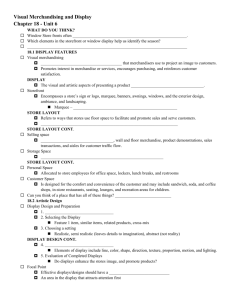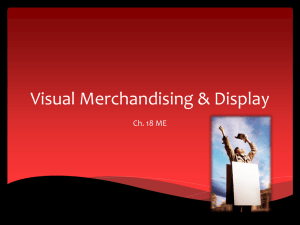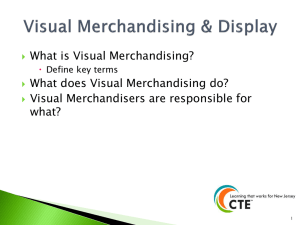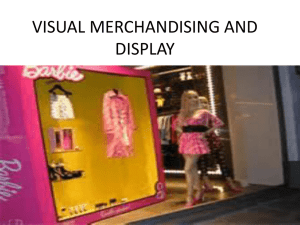Chapter 18 Visual Merchandising
advertisement
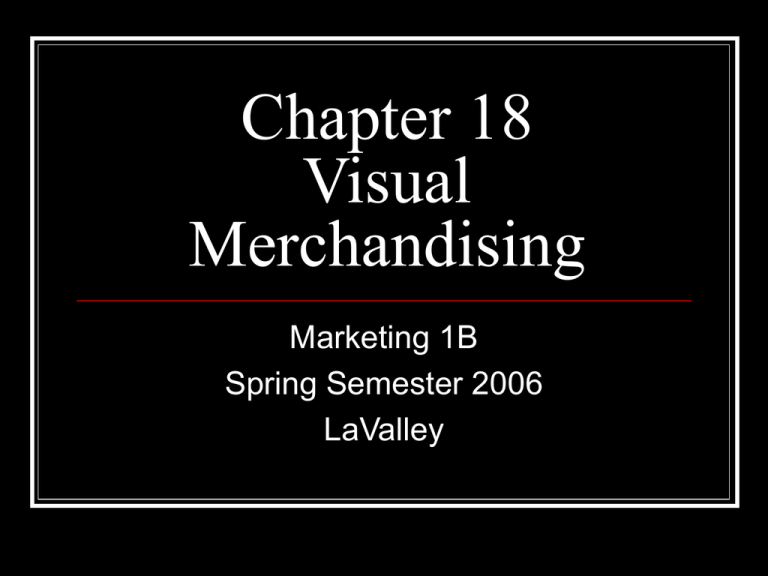
Chapter 18 Visual Merchandising Marketing 1B Spring Semester 2006 LaValley Table of Contents Display features What is Visual Merchandising? Elements of Visual Merchandising Storefront Store Layout Store Interior Interior Displays Table of Contents Continued… Artistic Design Display and Design Preparation Selecting Merchandise Selecting Display Choosing a setting Manipulating Artistic Elements Evaluating displays Display Maintenance What is Visual Merchandising? Definition The coordination of all types of physical elements in a place of business that are used to project the right image to its customers The Right Image Invites interest in the merchandise …come hither…. Encourages purchasing Makes the customer feel good about where he or she is doing business Creates a vision of the organization Draws in the customer A Successful Business… Creates the following.. Distinct Clear Consistent image ALL FOR THEIR CUSTOMERS!! A good image sets a business apart from the competition. Image is…. A blend of the following Store characteristics Location Products Prices Advertising Public relations Personal selling Visual Merchandise Where is it used?? Manufacturers’ showrooms Trade Shows Weathershield SHOT Show, Las Vegas Conventions ATA, Indianapolis Visual Merchandise continued… Involves the visual and artistic aspects of the entire business environment Visual Merchandising and displays are NOT the same thing!! Display is the visual and artistic aspects of presenting a product to a TARGET group of customers. Increase in VM…why?? Growth of “self-service”, “superstores”, and “box stores” Walmart Little personal selling Products MUST sell themselves! Example… Box Stores Develop GIANT signs Graphics Banners Usually to a DESIGNATED part of the store. Elements of Visual Merchandising Create a positive shopping experience Make your customers want to return! Key Store Elements Store front Store layout Store interior Interior display Store Front The total exterior of a business Store fronts include… Store’s sign Marquee Outdoor lighting Banners Planters Awnings Windows The building itself! How important is the store front?? VERY IMPORTANT!!! This projects the image of the store Signs First impressions Make a statement! Original Easily recognizable Letters, building materials, colors are used to help create the stores image Designed to attract attention Marquee Architectural canopy Extends over a store’s entrance More prominence Think…Bloomingdales, Saks, movie theaters.. Entrances Customer convenience Store security How many entrances? Types of entrances Revolving Push-pull Electronic Climate controlled Window Displays Display windows Attract attention Begin the selling process before the customer walks in the store! Suggesting type of merchandise and atmosphere of the store Two different kinds Promotional display Institutional display Promotional Displays Promote the sale of one product, a line of related products, or a variety of products How do they do that!? Emphasize a theme Promote storewide events Institutional Displays Promote the store (instead of the product) Image Focus on public causes, worthy ideas, or community organizations Show the business is interested in the community Store Layout The way store floor space is used to facilitate and promote sales Best serve the customer Four different kinds of space Selling space Merchandising space Personnel space Customer space Store Interior After general placement of merchandise is established, visual merchandising is decided. Selection of floor and wall coverings, lighting, colors, store fixtures EX: Supermarkets vs. Specialty stores Store Interior continued… Colors Bright colors vs. pastels Fixtures What kind?? Permanent or movable What about walls?? What image do you want to project? Walmart vs. Specialty shop Store Interior continued… Store aisles Width…different widths create different images Merchandise Size, variety, and quality of the merchandise Brand names vs. Generic Interior Displays Displays generate ONE out of every FOUR sales!! If done well…customers make a selection without assistance! Five types Closed displays Open displays Architectural displays Point-of-purchase displays Store decorations Interior Displays continued… Architectural displays Store decorations Allow customers to handle the merchandise Closed displays Seasonal or holiday displays Open displays Model rooms See but don’t touch! Point-of-Purchase displays Impulse buying! Interior Displays continued… ID’s use fixtures and props to showcase merchandise Create a clean and organized visual display Group merchandise by type Most stores are a combination of all display types Displays compliment each other, and create a positive buying experience. Interior Props Two different kinds Decorative Decorative Functional Background scenery used to indicate a season Create an interesting setting Functional Props Items for holding merchandise EX: Mannequins and shirt forms. Artistic Design Display Design and Preparation FACT: Displays have three to eight SECONDS to attract a customer’s attention, create a desire, and sell a product. Display and Design Preparation Involves the following five steps: Selecting Merchandise for display Selecting the display Choosing a setting Manipulating Artistic Elements Evaluating completed displays
